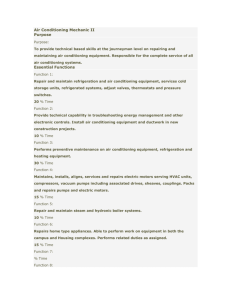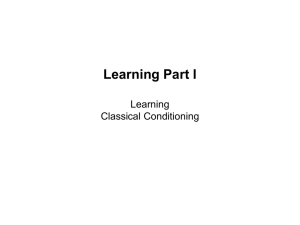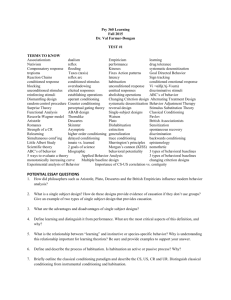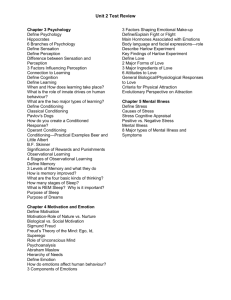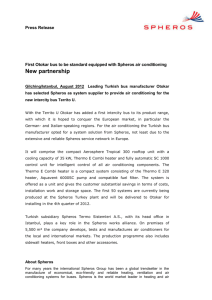Contingency Theory and Classical Autonomic
advertisement
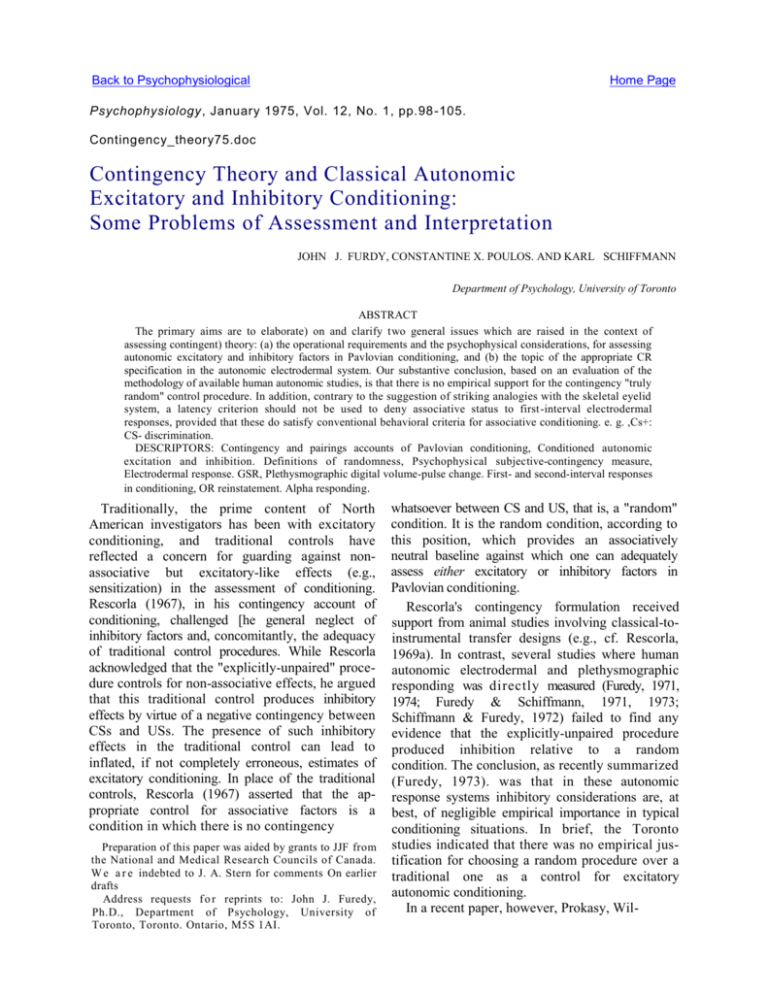
Back to Psychophysiological Home Page Psychophysiology, January 1975, Vol. 12, No. 1, pp.98 -105. Contingency_theory75.doc Contingency Theory and Classical Autonomic Excitatory and Inhibitory Conditioning: Some Problems of Assessment and Interpretation JOHN J. FURDY, CONSTANTINE X. POULOS. AND KARL SCHIFFMANN Department of Psychology, University of Toronto ABSTRACT The primary aims are to elaborate) on and clarify two general issues which are raised in the context of assessing contingent) theory: (a) the operational requirements and the psychophysical considerations, for assessing autonomic excitatory and inhibitory factors in Pavlovian conditioning, and (b) the topic of the appropriate CR specification in the autonomic electrodermal system. Our substantive conclusion, based on an evaluation of the methodology of available human autonomic studies, is that there is no empirical support for the contingency "truly random" control procedure. In addition, contrary to the suggestion of striking analogies with the skeletal eyelid system, a latency criterion should not be used to deny associative status to first -interval electrodermal responses, provided that these do satisfy conventional behavioral criteria for associative conditioning. e. g. ,Cs+: CS- discrimination. DESCRIPTORS: Contingency and pairings accounts of Pavlovian conditioning, Conditioned autonomic excitation and inhibition. Definitions of randomness, Psychophysi cal subjective-contingency measure, Electrodermal response. GSR, Plethysmographic digital volume-pulse change. First- and second-interval responses in conditioning, OR reinstatement. Alpha responding. Traditionally, the prime content of North American investigators has been with excitatory conditioning, and traditional controls have reflected a concern for guarding against nonassociative but excitatory-like effects (e.g., sensitization) in the assessment of conditioning. Rescorla (1967), in his contingency account of conditioning, challenged [he general neglect of inhibitory factors and, concomitantly, the adequacy of traditional control procedures. While Rescorla acknowledged that the "explicitly-unpaired" procedure controls for non-associative effects, he argued that this traditional control produces inhibitory effects by virtue of a negative contingency between CSs and USs. The presence of such inhibitory effects in the traditional control can lead to inflated, if not completely erroneous, estimates of excitatory conditioning. In place of the traditional controls, Rescorla (1967) asserted that the appropriate control for associative factors is a condition in which there is no contingency Preparation of this paper was aided by grants to JJF from the National and Medical Research Councils of Canada. W e a r e indebted to J. A. Stern for comments On earlier drafts Address requests f o r reprints to: John J. Furedy, Ph.D., Department of Psychology, University of Toronto, Toronto. Ontario, M5S 1AI. whatsoever between CS and US, that is, a "random" condition. It is the random condition, according to this position, which provides an associatively neutral baseline against which one can adequately assess either excitatory or inhibitory factors in Pavlovian conditioning. Rescorla's contingency formulation received support from animal studies involving classical-toinstrumental transfer designs (e.g., cf. Rescorla, 1969a). In contrast, several studies where human autonomic electrodermal and plethysmographic responding was directly measured (Furedy, 1971, 1974; Furedy & Schiffmann, 1971, 1973; Schiffmann & Furedy, 1972) failed to find any evidence that the explicitly-unpaired procedure produced inhibition relative to a random condition. The conclusion, as recently summarized (Furedy, 1973). was that in these autonomic response systems inhibitory considerations are, at best, of negligible empirical importance in typical conditioning situations. In brief, the Toronto studies indicated that there was no empirical justification for choosing a random procedure over a traditional one as a control for excitatory autonomic conditioning. In a recent paper, however, Prokasy, Wil- January 1975 CONTINGENCIES AND CONDITIONING 99 ever, the seeming plausibility of this type of argument derives directly from an inappropriate application of a traditional pairings analysis to the notion of randomness. It is a traditional pairings analysis which focuses solely on forward CS-US occurrences, and a traditional pairings analysis provides no definition of randomness. On the other hand, it is a central tenet of the contingency formulation, that contingencies are operationally defined in terms of US occurrences during the absence as well as the presence of the CSs. More specifically, the operational specification of randomness is that the probability of US occurrence is equal given the presence or absence of the RS. In terms of conditional probabilities, then, an RS meets the specification for randomness when it is the case that P(US/RS = P(US/RS). It should be noted that the RSs in the Toronto studies do fulfill this contingency Assessment of the Contingency Formulation: requirement for randomness. It is now worthwhile to consider the implications Operational, Psychophysical, and Theoretical of the differential rate of accidental RS-US Considerations pairings between the Toronto and the Prokasy et Rescorla's contingency account implies that the al. studies. First, it should be clear that the temporal presence of inhibition is indicated by performance density of USs is an important determinant of the to a random signal (RS) exceeding performance to number of accidental RS-US pairings. Thus one a CS-. As indicated, the Toronto studies have reason for the difference in the number of RS-US consistently failed to find any such RS >CS- pairings was that US density in both Toronto outcome, while Prokasy et al. (1973) found that, studies was far lower (rate of less than I per min) in some cases, performance to RS did exceed CS— than the 95-USs-per-4fi-nun rate used by Prokasy performance. In questioning the operational el al.1 However, (he critical point is that in assessing specifications of the two earliest Toronto studies, contingency theory in arty Pavlovian conditioning Prokasy et al. (197.8, p. 152) have suggested that situation, the use of the number of accidental RSthe RS in those studies was not "truly" random US pairings as an index of randomness involves because it was more like a CS- in that there were applying an inappropriate pairings analysis to the relatively few accidental occurrences of a US notion of randomness. Contingency theory, as closely following RS onset. Using Prokasy et al.'s indicated above, asserts that a random stimulus is example, there were three US occurrences within one where "the probability of a US is the same 10 sec following RS onset in the Furedy and given either the presence or absence of the CS Schiffmann (1971) study, while, in contrast, Prokasy [Rescorla. 1969a, p. 65]." et al.'s study involved 13 USs occurring within 10.2 The maintenance of this equality for ransec of RS onset. domness can pose special problems whenever the The suggestion that the distinction between RS contingency position is assessed with a multipleand CS-, and with it, the notion of randomness, rests, cue design, that is, whenever the same 5 receives in some way, on the number of accidental US more than one type of CS. In non-autonomic occurrences closely following RS, does have some studies (cf. Rescorla, initial plausibility. If there are few occurrences of 1 It is worth noting that the particular US density used a US following RS, then, the RS in this sense be- in the Toronto studies was chosen to approximate comes similar to an actual CS-, and it might be frequently employed e.g. Gate & Stern, 1967; Prokasy & thought that this similarity indicates that the Ebel. 1967), though obviously not universal, autonomic conditioning parameters. This tactic reflected a primary nominal RS is not "truly" random. How- Hams, Kumpfer, Lee, and Jenson (1973) reported data on human autonomic electrodermal skinconductance responding (SCR) which were interpreted as providing some support for the contingency viewpoint that the explicitly unpaired CS (i.e.. CS-) involves inhibitory effects. These investigators questioned the appropriateness of the methodology and conclusions of the two earliest Toronto studies (Furedy, 1971; Furedy & Schiffmann, 1971). Although we shall discuss these specific questions, our primary purpose is to elaborate and clarify two more general issues raised by Prokasy et al. The f i r s t issue concerns the operational requirements and the psychophysical considerations for assessing autonomic excitatory and inhibitory factors in Pavlovian conditioning. The second issue involves a re-examination of the topic of the appropriate CR specification in the autonomic electrodermal system. concern with assessing the implications of Rescorla's contingency account for control procedures in common autonomic conditioning situations. 100 FUREDY, POULOS and SCHIFFMANN 1969b) the design has typically involved three different groups, respectively, receiving CS-h RS, and CS-. On the other hand, both the Toronto studies and the Prokasy et al. (1973) experiment presented more than one type of CS to the same S.2 The special problems that can arise with such multiple-cue designs can best be illustrated by analyzing the procedures of Prokasy et al. (1973) who presented all three types of CSs (CS+, RS, CS-) to the same S. To generate the three types of CSs, Prokasy et al. initially randomly distributed three kinds of events (which were later to serve respectively, as CS+ RS, and CS-) among the time units of the session. Specifically, 44 "CS+s", 44 "RSs" and 43 "CS-s" of 5-sec duration each were randomly distributed among 540, 5.1-sec time units (i.e., a 46-min session), Following this, 95, .2-sec USs were randomly distributed among the 2700 1.02-sec time units of the session. Ai this point in the procedure, it should be clear that all three types of CSs were random with respect to the USs. That is, for all types of C S s , i t w a s t h e c a s e t h a t P ( U S / C S ) = P (US/CS). At this point, the protocols were altered to produce functional CS+s and CS-s. Specifically, CS+s were made excitatory by taking all USs which randomly occurred within 13 sec of CS+ onset and placing each US exactly at CS+ offset. More importantly, the CS-s were similarly made inhibitory by omitting all USs which had (randomly) occurred within 13 sec of CSonset. No changes were intentionally introduced for the initially random RS, but, because of this particular within-S procedure and the altered CSprotocols, it is not the case that RS remained random. This fact clearly emerges from considering the specification that randomness entails that probability of US occurrence be equal given the presence and absence of RS [P (US/RS) 2 Such multiple-cut designs are of special interest f o r psychophysiologists, especially because the differentialconditioning or double-cue form of this sort of design has come to be most widely used in recent years to assess the amount of autonomic conditioning. Contingency theory as formulated by Rescorla (1967, 1969b) has set no boundary conditions which would exclude multiple-cue design from consideration. Nevertheless, it will be recognized that the empirical basis of contingency theory rests on evidence obtained from single-cue designs (Rescorla. 1967, 1969). Accordingly, it might be suggested that it is conceivable that for the clear emergence of the sort of contingency influences described b) Rescorla, it is necessary, or at least desirable, that there be only one sort of CS for each S. Vol. 12, no. 1 = P (US/RS)], and recognizing that in the Prokasy et al. procedures, RS absence (RS) encompasses those intervals in which CS- and the attendant omission of USs occurred. An example from Rescorla's (1967, p. 79) paper is to the point: suppose one group received a "truly-random" presentation of CSs and USs, and a second group received the identical treatment except that the USs which were preprogrammed to occur in absence of the CS were omitted. Rescorla asserts that the omission of USs during CS absence in the second condition would transform it from a random condition to an excitatory one. Similarly, in Prokasy et al.’s study, the alteration of protocols for CS- involving the omission of U S s reduced the number of US occurrences in RS absence. Within the contingency formulation, the "RS" in this study then meets the specification of an excitatory CS since US occurrence is mere probable in the presence of RS than in its absence, i.e., [P (US/RS) >P (US/RS)|. Up to this point, we have restricted our discussion of the methodological aspects of assessing contingency theory to operational (i.e. physical) conditions. However, relevant also to any experimental assessment of contingency theory is a basic ambiguity which is introduced by the theory's working assumption that psychological or subjective contingencies parallel the physical or objective contingencies, Both Prokasy (1965, p. 223) and Rescorla have drawn attention to this problem, the latter indicating that "the limits of our operational procedures do not necessarily define the limits of psychological processes in the organism [Rescorla. 1967, pp. 77-78]." The problem, then, is that a CS which is random (or negatively or positively correlated) with respect to the US may not, in fact, be so for the organism, and this problem clearly complicates any assessment of the contingency position. The importance of dealing with this problem is directly proportional to the considerable influence that contingency theory has recently enjoyed. However, with human-based studies, it is fortunately not the case (cf. e.g., Furedy, 1973) that the "solution to this problem requires an ability, which we do not yet have, to identify the psychological processes [Rescorla. 1967, p. 78]." That sort of identification was sought by Prokasy et al. (1973) in their human-based study, but neither their procedures nor their method of gathering those aspects of the January 1975 CONTINGENCIES AND CONDITIONING 101 least with the same precision and care as the autonomic dependent variable. Aside from the above operational and psychological considerations, it seems of interest to explicitly consider the theoretical implications of a given outcome for resolving the issue between the traditional pairings and the contingency formulations. Specifically, if an outcome of RS >CS- is obtained from a soundlybased experiment, how would this outcome be interpreted with respect to the two competing formulations? A contingency formulation would, of course, assert that CShad acquired inhibitory properties. However, a pairings account could assert that an RS > CS- finding indicates merely that the RS has acquired excitatory properties via accidental RS-US pairings. It should be noted, moreover, that the plausibility of this interpretation increases directly with the rate of such RS-US pairings, a point which can be illustrated by considering the high-US-density rate study of Prokasy el al. (1973). Assume, for the moment, that their RS was operationally random. In that case, translated from expected probabilities (for 13-sec intervals) to pairings terminology, their RS can be stated to have involved ("accidental") conditioning with a 39%-reinforcement schedule with a variable IS1 ranging from 0 to 13 sec, while their CS-, of course, involved a 0% reinforcement schedule. Clearly there is no difficulty in suggesting that such an "RS" had acquired excitatory properties. Moreover, it should be noted that the CS+ in that study also involved no more than a 39% reinforcement schedule, although at a constant 5-sec 1SI rather than variable as for the RS. In fact, then, from a pairings analysis it could be suggested that RS and CS+ may have involved excitatory conditioning of the same order of magnitude. 3For example, Furedy and Baer (1966) have reported that For example, with 100% reinforcement, Peeke the concurrent measure used by them facilitated differential and Grings (1966) found that SCR conditioning autonomic conditioning. It is likely, but not yet clear, that the concurrent measures used by Furedy and Schiffmann (1973) with a constant 5-sec LSI was no greater than and by Dawson and Biferno (1973) are less “obtrusive” than that produced by a variable IS1 which ranged that used by Fuhrer and Baer, since the measure used by from V2 to 11 sec. This analysis explicates the these latter investigation involved E repeatedly demanding seemingly surprising findings of no intertrial reports from S. Moreover, the potential effect of using concurrent measurement o f subjective contingency differences between CS+ and RS performance on would seem to work to augment, rather than hinder, the first-interval response performance in general, and possibility of producing contingency-type autonomic outcomes. on the second-interval response frequency Accordingly, given that the autonomic outcome does not measure (as applied to all, rather than to selected conform to contingency expectations, as in the relevant 5s; Prokasy et al., 1973, p. 150). Toronto study (Furedy & Schiffmann 1973), the interpretation In contrast, a comparable 13-sec interval for a of such on outcome would no be confounded by the low-US-density study (e.g., Furedy 8c Schiffmann, concurrent-measurement factor. 1971) involved ("accidental") data seem optimal. Specifically, the practice of idling >S's in advance that there would be a CS+, a CS-, and an RS which would be “entirely random with respect [Prokasy el al., 1973, p, 148]” to the US introduces a procedural element which may have induced an answer based more on compliance than on the perception of the contingencies associated with the CSs. Because of those prior instructions, and the way in which the data relevant to this issue were gathered, this aspect of the study may amount to no more than determining whether .Ss could tell the three CSs apart from each other. It is at least possible that the CS+ and the RS were not differentiated by S in terms of CS-US contingency, nor even in terms of amount of CS-US pairings. That is, CS+ may have been perceived as being followed less than half the time by a noise at a constant interval, whereas RS may seem to have been followed at the same rate, but at a variable interval. The method used to measure subjective contingency in the early Toronto studies (Furedy & Schiffmann. 1971; Schiffmann & Furedy, 1972) did not suffer from the above problems, but was still far from optimal in terms of sheer sensitivity, became it amounted to no more than asking .Ss (once only) to recall what had happened as regards the relationship between the CSs and the US (for critique, cf. Furedy. 1973, pp. 1 1 0 - 1 1 1 ) . The sensitivity problem has been overcome by more recent studies which have used a concurrent measure of subjective contingency of either continuous (e.g., Furedy & Schiffmann, 1973) or discrete (Dawson & Biferno, 1973) form. This is not to say that no problems of confounding remain, 3 but it is clear that in human conditioning research, where the clarity of perceived contingency differences between CSs is critical, subjective CSUS contingency should be measured at 102 FUREDY, POULOS and SCHIFFMANN conditioning of RS with an 8.7% reinforcement schedule and 0-13 sec variable LSI, while CSinvolved a 0$, and CS+ an 80% reinforcement schedule, Because of the low reinforcement rate for RS in this case, an RS > CS- outcome (which did not obtain) would be less plausibly interpreted in terms of accidental excitatory conditioning to RS. Nevertheless, a pairings account could still logically persist in such an interpretation. Accordingly, evidence based solely on an RS > CS- outcome would, in and of itself, be equivocal with regard to arbitrating between the contingency and pairing formulations. While such an outcome may provide a first step toward validating contingency theory, the subsequent but necessary experimental problem would become one of demonstrating active inhibitor) properties for CS- and associatively neutral properties for RS. These types of methodological problems have been extensively treated by Hearst (1972) and Rescorla (1969b). It should be noted, however, that when no RS:CSdifferences are obtained, as in the Toronto studies, no further steps need be taken along such lines. Appropriate CR Specification in the Autonomic Electrodermal System In the more specific context of assessing contingency theory, Prokasy el al. (1973) have raised the CR specification issue in drawing attention to the fact that with sufficiently long interstimulus intervals (ISIs) it is possible to measure first- and second-interval responses which occur before US onset. Briefly slated, their suggestion is that the second-interval response (SIR) may be the more appropriate measure of excitatory and inhibitory effects rather than the firstinterval response (FIR). Their main reasons for this suggestion are that FIR is affected by stimulus sequences, and, more importantly, is elicited by signal onset. The question of CR specification is, of course, critical for any area of conditioning. Consequently, it is of considerable importance to psychophysiologists to clearly separate and critically evaluate the primary issues which were alluded to in the Prokasy el al. (1973) article, and which are frequently invoked in the literature (e.g., Suboski, Brace, Jarrold, Teller. & Dieter, 1972). The central core of the controversy on appropriate CR specification involves the ba- Vol. 12, no. 1 sic assertion that the FIR may not be clearly interpretable as a measure of conditioning. It is important to distinguish between two formulations of the argument which denies associative status for the SCR FIR, although both formulations involve the claim that the FIR is no more than an orienting response (OR) as described by Sokolov (1960). One formulation also involves an implicit referral to the reinstatement of the OR as a function of a change in the stimulus sequence. Specifically, when the LSI in a conditioning study is shorter than the latency of the FIR, CS alone test trials are needed to assess conditioning, and these trials constitute changes in the stimulus sequence of (repeated) CS-L'S trials. According to the stimulussequence formulation, then, the FIR measured on these CS alone lest trials could be due to the OR elicited by the change in stimulus sequence, a possibility which has been elaborated in more detail elsewhere (e.g., Furedy, 1968). It should first be noted that, contrary to the claim that ORs are quite sensitive to stimulus sequences, there is evidence (Furedy, 1968) that the SCR OR does not increase to change from a relatively simple pattern of repeated alternation. More importantly, the change-in-sequence form of the OR argument could apply only to the single Toronto study where FIR latency exceeded the ISI (Furedy & Schiffmann. 1971) and not to those where the ISI exceeded FIR latency (Furedy, 1971, 1974; Furedy & Schiffmann, 1973: Schiffmann & Furedy, 1972). In contrast, the other formulation of the OR argument applies potentially to all F I R s irrespective of 1ST. According to this formulation, FIR is not a genuine CR or is non-associative, because it is signal elicited (rather than being change elicited, as in the stimulus-sequence formulation). This formulation, then, classifies the FIR as nonassociative and the SIR as associative on the basis of a latency criterion. The use of a latency criterion itself appears to be based on the analogy between the SCR FIR and the eyelid “FIR.” The “FIR” in (he eyelid system is the so-called 'alpha" response which occurs at latencies between 40 msec and 120 msec following CS onset, and which, as indicated by the earlier work of Grant and his associates (e.g.. Grant Sc Adams, 1944), is not an associative response. In eyelid conditioning, it is a well-established practice to use a latency cri- January 1975 CONTINGENCIES AND CONDITIONING terion for specifying or distinguishing CRs from other responses (e.g., Gormezano, 1966, p. 403). For the electrodermal SCR system, the latency criterion was first proposed by Stewart, Stern, Winokur, and Fredman (1961). Later, Prokasy and Ebel (1967) suggested a si liking parallel between the SCR FIR and the eyelid alpha response, although these authors did not deny the possibility of associative status for the SCR FIR.4 For the psychophysiologist concerned with conditioning in the electrodermal SCR system, the crucial empirical question is: How well does the analogy from eyelid conditioning apply? Stewart et al.’s (1961) latency-criterion claim drew relatively immediate methodological criticism from Lockhart and Grings (1963), and from Kimmel (1964). Subsequently, Lockhart (1966) cited substantial SCR evidence against the Stewart et al. (1961) latency criteria indicating that it was behaviorally invalid to assert the latency-based associative/nonassociative distinction, Lockhart (1966) advocated the use of neutral terms to describe multiple SCRs occurring during the ISI, rather than “prejudging the nature of the various responses in the absence of empirical proof [Lockhart, 1966. p. 109].” It bears emphasis that the argument was not over the existence of multiple responses during the ISI, but rather over the adequacy of the latency criterion for distinguishing between (nonassociative) ORs and (associative) CRs. This confused SCR picture of the sixties contrasts sharply with the earlier and relatively clear case for eyelid conditioning, where the latency distinction between alpha responses and CRs was generally accepted because of the clear behavioral validation of the differences between the two sorts of responses. These behavioral differences, which have failed to emerge in the case of the FIR and SIR SCRs, involve two crucial aspects. First, the eyelid “FIR” (alpha) habituates over trials whereas the longerlatency CR increases over trials. In Prokasy and Ebel’s (1967) SCR study, the investigators emphasized that the same sort of FIR-SIR pattern emerged over trials. However, it should be noted that in the Prokasy el al. (1973) study, both the SIR and FIR functions decreased 4 Elsewhere (Furedy & Schiffmann. 1974. p. 65) we may have inadvertently given the impression that Prokasy and Ebel (1967) explicitly den ied associative status of the FIR, but this is not the case. 103 over trials. More generally, unlike the situation with the eyelid response, differential FIR-SIR trials functions are far from universally found in SCR conditioning studies. The second and more important behavioral difference between eyelid alpha responses and responses occurring later during the ISI is that the eyelid “FIR” (alpha) can be accounted for in terms of sensitization (presence of the US) Father than conditioning (paired CS-US presentations). The terminological distinction between “sensitization” and “conditioning” has sometimes been confused. For example, despite the “Conditioning of alpha” title of the paper of Grant and Adams (1964), the evidence from that early experiment really indicated that the alpha responses were sensitized rather than conditioned. It has become generally accepted that the differential conditioning paradigm serves as a control for sensitization so that “conditioning (is) demonstrated by a difference in responding between CS+ and CS- [Gormezano, 1966, p. 389].” In these terms the eyelid “FIR” is clearly a sensitized response. To counter an analogous claim for the SCR FIR, the burden then for psychophysiologists was to demonstrate differential conditioning of the FIR: that is, to show that the SCR FIR was not due merely to sensitization. As early as one year after the Stewart et al. (1961) paper, Grings, Lockhart, and Dameron (1962) noted that SCR FIRs do show differential (CS+ > CS-) performance, and warned "that it does not help to attribute t hi s difference to sensitization or pseudoconditioning (Stewart et al., 1961), unless one wishes to start talking about ‘differential sensitization due to CS-LS pairing’ [ G r i n g s et al., 1962, p. 29]." Even Stern, who was one of the coauthors of the Stewart et al. (1961) paper, appears to have accepted that FIR SCRs are associative, since, on obtaining differential F I R SCR performance in a later study, he reported this finding as indicating “classical conditioning (our emphasis) of the electrodermal OR [Gale & Stern, 1967].” There is at least one experiment in the SCR literature where differentiation was obtained in the SJR, but not in the FIR (McDonald & Johnson, 1965), but not only are there a number of SCR experiments where differentiation was obtained in both responses (e.g., Prokasy & Ebel, 1967; Prokasy et al., 1973), but there are also a number of SCR experiments where clear differentiation 104 FUREDY, POULOS and SCHIFFMANN was obtained only in the FIR (Dawson, 1970: Dawson & Biferno, 1973; Furedy, 1973; Schiffman & Furedy, 1972). It is dear then, that the behavioral sensitization-conditioning difference that holds between the eyelid “FIRs” and “SIRs” does not hold between SCR FIRs and SIRs. A final argument for the possible nonassociative status of the SCR FIR which needs consideration is Prokasy et al.'s (1973) suggestion, based on their earlier study (Prokasy & Ebel. 1967), that FIR and SIR are not correlated. It seems in order to note that such correlationbased evidence has not been commonly adduced to support the claim that eyelid alphas were not CRs, presumably because other, more direct, behavioral evidence was already sufficient to establish this point. That this sort of directness is lacking in the case of evidence on nonsignificant correlations can be illustrated by considering two alternative interpretations of such evidence, interpretations which are both plausible and which assume that both FIR and SIR are CRs. One of these interpretations is that one of the responses in question may be insufficiently reliable, and it will be recognized that low reliability in even one response is sufficient to produce nonsignificant correlations. The other interpretation is that a positive relationship between FIR and SIR (by virtue of them both being CRs) has been masked by a response-interference factor (e.g., Grings & Schell, 1969; Furedy & Scull, 1971). This factor, of course, would produce negative correlations inasmuch as relatively strong FIRs would be followed by (more interfered with) relatively weak SIRs. All this is not to deny that drawing attention to a possible analogy with the skeletal eyelid is of potential value. Also, it may well be the case that the SCR FIR, since it is at least partly elicited by signal onset, has a considerable OR component in it, a component which it may not share with the SIR. What we would emphasize, however, is that, in contrast with the eyelid system, the evidence relevant to the electrodermal SCR in no way supports the application of the latency criterion 10 rule out FIRs as indices of conditioning. Provided that conventional behavioral requirements of conditioning (e.g., CS+ performance exceeding CS- performance in a differential conditioning paradigm) Vol. 12, no. 1 are met, as in the FIR results of the Toronto assessments of the existence of conditioned autonomic inhibition (Furedy, 1971, 1974; Furedy & Schiffman, 1971.' 1973; Schiffmann & Furedy, 1972), the latency-criterion formulation of the OR argument cannot validly be used to classify FIRs as nonassociative. Conclusions This paper was initiated by some questions raised (Prokasy et al., 1973) concerning the methodology of the Toronto studies, but our main purpose here has been to provide clarification and conclusions that are of more general interest. One set of conclusions relates to the assessment of the contingency formulation of any response, skeletal or autonomic. The first of these is the methodological point that the randomness of a nominal RS in any given experiment is determined by whether it meets the contingency formulation (e.g., Rescorla, 1967) condition of P(US/CS= P(US/CS). To try to determine randomness by the number of times the US closely follows the RS is to misapply a traditional pairings analysis to the concept of randomness. The second point is the importance, in human-based studies, of measuring subjective CS-US contingency with at least the same precision and care as the response being conditioned so that we can "identify the psychological processes [Rescorla. 1967, p. 78]." The third point relates to the impact of RS > CSand RS > CS- outcomes on the dispute between the contingency and pairings accounts of conditioning, and involves die twin assertions that while the former outcome is only the first step of many that are necessary for supporting a contingency position, the latter outcome, by itself, provided that adequate sensitivity has been demonstrated, is sufficient for rejecting the contingency analysis for that particular form of conditioning. The other set of conclusions relates to the question of the appropriate CR specification in the autonomic electrodermal system, and these conclusions may be summarized by the assertion that while analogies with other response systems may be heuristic, those analogies should not be allowed to determine CR specification in the electrodermal response system. In other words, questions concerning autonomic behavior should, in the end, be decided by observations based on that behavior itself. January 1975 CONTINGENCIES AND CONDITIONING 105 REFERENCES Dawson. M. E., Cognition and conditioning: Effects of masking the CS-US contingency on human GSR classical conditioning. Journal of Experimental Psychology, 1970, 85, 389-396. Dawson, M. E., & Biferno. M. A. Concurrent measurement of awareness and electrodermal classical conditioning. Journal of Experimental Psychology, 1973. 101, 55-62, Fuhrer, M. J., & Baer, P. E., Effects of intertrial reports on cognitive and GSR differentiation of conditional stimuli. Proceedings of the 74th Annual Convention of the American Psychological Association, 1966, 53-54. Furedy, J. J. Human orienting reaction as a function of electrodermal versus plethysmographic response modes and single versus alternating stimulus series. Journal of Experimental Psychology, 1968, 77, 70-78. Furedy, J. J. Explicitly-unpaired and truly-random CS-controls in human classical differential autonomic conditioning. Psychophysiology, 1971, 8, 497-503. Furedy. J. J. Some limits on the cognitive control of conditioned autonomic behavior. Psychophysiology, 1973, 10, 108-111. Furedy, J. J. Experimental assessments of the importance of controlling for contingency factors in human classical differential electrodermal and plethysmographic conditioning. Psychophysiology, 1974. 11. 308-314. Furedy. J. J., & Schiffmann, K., Test of the propriety of the traditional discriminative control procedure in Pavlovian electrodermal and plethysmographic conditioning, Journal of Experimental Psychology, 1971, 91, 161-164. Furedy, J. J., & Schiffmann K., Concurrent measurement of autonomic and cognitive processes in a test of the traditional discriminative control procedure for Pavlovian electrodermal conditioning, Journal of Experimental Psychology, 1973, 100, 210-217. Furedy, J. J., & Schiffmann, K., Interrelationships between human classical differentia electrodermal conditioning orienting reaction, responsivity, and awareness of stimulus contingencies. Psychophysiology, 1974, 11, 58-67. Furedy, J. J., & Scull, J. Orienting-reaction theory and an increase in the human GSR following stimulus change which is unpredictable but not contrary to prediction, Journal of Experimental Psychology, 88, 292-294. Gale, E. N., & Stern, J. A., Conditioning of the electrodermal orienting response. Psychophysiology, 1967, 3, 291-301. Gormezano, I., Classical conditioning. In J. B. Sidowski (Ed.), Experimental methods and instrumentation in psychology. New York: McGraw-Hill, 1966, pp. 385-420. Grant. D. A., & Adams. J. K. "Alpha" conditioning in the eyelid. Journal of Experimental Psychology, 1934, 34, 136142. Grings. W. W., Lockhart, R. A., & Dameron. L. E. Conditioning autonomic responses of mentally sub- normal individuals. Psychological Monographs, 1962, 76 (39, Whole No. 558). Grings, W. W., & Schell. A. M., Magnitude of electrodermal response to a standard stimulus as a function of intensity and proximity of a prior stimulus. Journal of Comparative & Physiological Psychology, 1969, 76, 77-82. Hearst. E. Some persistent problems in the analysis of conditioned inhibition. In R. A. Boakes & M. S. Halliday (Eds.). Inhibition and learning, New York: Academic Press. 1972, pp. 5-39. Kimmel. H. D., Further analysis of GSR conditioning: A reply to Stewart, Stern, Winokur and Fredman, Psychological Review, 1964, 71, 160- 166. Lockhart, R. A. Comments regarding multiple response phenomena in long interstimulus interval conditioning, Psychophysiology, 1966, 2, 108-114. Lockhart. R. A., & Grings, W. W. Comments on "An analysis of GSR conditioning." Psychological Review 1963, 70, 562564. McDonald. D. G., & Johnson, I. C., A reanalysis of GSR conditioning. Psychophysiology, 1965, 1, 291-295. Prokasy, W. F. Classical eyelid conditioning: Experimenter operations, task demands, and response shaping. In W. F. Prokasy (Ed.). Classical conditioning: A symposium. New York: Appleton-Century-Crofts, 1965. Pp. 208-222. Prokasy, W. F., & Ebel, H. C., Three components of the conditioned GSR in human subjects. Journal of Experimental Psychology, 1967, 73, 247-256. Prokasy, W. F., Williams, W. G., Kumpfer. K. L., Lee. W. V., & Jensen, W. R, Differential SCR conditioning with two control baselines: Random signal and signal absent. Psychophysiology, 1973, 10, 145-153. Rescorla, R. A., Pavlovian conditioning and its proper control procedures. Psychological Review, 1967. 75, 71-80. Rescorla, R. A. Conditioned inhibition of fear. In W. K. Honig & N. J. Mackintosh (Eds.), Fundamental issues in associative learning. Halifax: Dalhousie University Press, 1960. Pp. 65-89. (a) Rescorla, R. A. Pavlovian conditioned inhibition. Psychological Bulletin, 1969, 72. 77-94. (b) Schiffmann M, K., & Furedy. J, J., Failures of contingency and cognitive factors to affect long-interval differential Pavlovian autonomic conditioning, Journal of Experimental Psychology, 1972, 96, 215-218. Sokolov, Y. N., Neuronal models and the orienting reflex. The central nervous system and behavior. Trans. 3rd Conf., Joseph Macy Foundation, New York. 1960. Pp. 187-271. Stewart M. A., Stern, J. A., Winokur, G., & Fredman. S., An analysis of GSR conditioning. Psychological Review, 1961, 68, 50-67. Suboski, M. D., Brace, T. G., Jarrold, L. A. , Teller, K., & Dieter, R. Interstimulus interval and time estimation in ratings of signaled shock aversiveness. Journal of Experimental Psychology. 1972, 96, 407-415.


